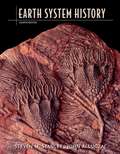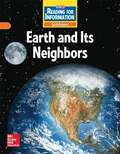- Table View
- List View
Earth Science: The Physical Setting
by Thomas McguireThis book helps students understand the fundamental concepts of earth science and become familiar with the Earth Science.
Earth System History (Fourth Edition)
by Steven M. Stanley John A. LuczajThe thoroughly updated new edition includes important new coverage on mass extinctions, climate change, and Proterozoic history, plus a range of interactive studying and teaching tools.
Earth Systems, an Earth Science Course
by CurrikiThe Open Source Earth Science course has been organized to meet the CA Science Standards for Earth Sciences in grades 9 - 10, as adopted by the California State Board of Education. This course is part of a set of collections that contain additional Earth Science resources on Curriki that can be accessed at www.curriki.org.
Earth Systems: Science Logbook (PhD Science™ #Level 5, Module 3)
by Great MindsNIMAC-sourced textbook
Earth and Its People: A Global History (AP edition)
by Daniel R. Headrick Pamela Kyle Crossley Richard W. Bulliet Lyman L. Johnson David Northrup Steven W. HirschThe book explores the common challenges and experiences that unite the human past.
Earth and Space Patterns (Inspire Science, Grade 5 #Unit 4)
by McGraw-Hill EducationNIMAC-sourced textbook
Earth and Space Science
by Kristine LindsayEarth and space are two unique systems, combinations of parts that work together. Earth science is the study of these two systems and how they are related.
Earth and Space Science Activity Book, Grade 5 (Knowing Science Activity Books #18)
by Knowing ScienceGrade 5 Earth and Space Science Activity Book from Knowing Science.
Earth and Space Science, First Student Edition
by Purposeful Design PublicationsEarth and Space! This textbook guides your child through a study of geology, oceanography, meteorology, astronomy, and environmental science. A thorough study of rocks, soil, and fossils will give your child ample proofs that this earth was created by God and not evolutionary processes.
Earth and Space Systems
by Nicholas MooreNIMAC-sourced textbook <p><p> Earth and Space Systems has students explore how Earth is both part of a larger system and is itself composed of interconnected systems.
Earth and Space Systems: Below-Grade Reader (Building Blocks of Science Literacy Series)
by Nicholas MooreLexile range: 610L–760L. Earth and Space Systems Below-Grade Reader gets kids thinking about Earth's place in space and its major systems. Topics include: Earth's Place in Space; Earth's Major Systems; Earth's Oceans; the Science and Engineering Practices of analyzing data; and learning about the career of a hydrologist.
Earth and Space, Exploring Space (Inspire Science #[Grade 6] Unit 1)
by Douglas Fisher Ralph M. Feather Jr. Alton L. BiggsNIMAC-sourced textbook
Earth and Space, Impacts on the Environment (Inspire Science #[Grade 6] Unit 3)
by Douglas Fisher Ralph M. Feather Jr. Alton L. BiggsNIMAC-sourced textbook
Earth and Space, The Changing Earth (Inspire Science #[Grade 6] Unit 4)
by Douglas Fisher Ralph M. Feather Jr. Alton L. BiggsNIMAC-sourced textbook
Earth and Space, Water and Climate (Inspire Science #[Grade 6] Unit 2)
by Douglas Fisher Ralph M. Feather Jr. Alton L. BiggsNIMAC-sourced textbook
Earth and Sun
by Lawrence Hall of Science University of California at BerkeleyNIMAC-sourced textbook
Earth and Sun
by Lawrence Hall of Science University of California at BerkeleyNIMAC-sourced textbook
Earth in Space (Student Guide and Source Book)
by Carol O'DonnellWith an appropriate curriculum and adequate instruction, middle school students can develop the skills of investigation and the understanding that scientific inquiry is guided by knowledge, observations, ideas, and questions.



